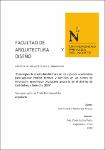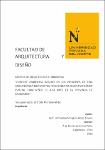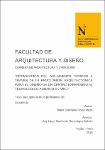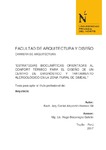Mostrar el registro sencillo del ítem
Estrategias de diseño bioclimático en los espacios académicos para generar confort térmico y lumínico en un centro de innovación tecnológico productivo pecuario en el distrito de José Gálvez – Celendín, 2018
| dc.contributor.advisor | Sullca Porta, Doris | |
| dc.contributor.author | Navarrete Araujo, Luis Ernesto | |
| dc.date.accessioned | 2018-10-10T00:54:24Z | |
| dc.date.available | 2018-10-10T00:54:24Z | |
| dc.date.issued | 2018-09-06 | |
| dc.identifier.citation | Navarrete, L. E. (2018). Estrategias de diseño bioclimático en los espacios académicos para generar confort térmico y lumínico en un centro de innovación tecnológico productivo pecuario en el distrito de José Gálvez – Celendín, 2018 (Tesis de licenciatura). Repositorio de la Universidad Privada del Norte. Recuperado de http://hdl.handle.net/11537/13915 | es_PE |
| dc.identifier.other | TES 720 NAVA 2018 | es_PE |
| dc.identifier.uri | https://hdl.handle.net/11537/13915 | |
| dc.description.abstract | En la actualidad, la necesidad de mejorar la calidad de los espacios para el usuario en diferentes proyectos arquitectónicos es esencial; por ello, la arquitectura alrededor del mundo ha ido evolucionando constantemente obteniendo diferentes estilos, uno de ellos es la Arquitectura Bioclimática la cual se enfoca en generar el confort ambiental hacia la persona en un ambiente, ya sea térmico, lumínico, acústico, olfativo, entre otros, a través de diferentes estrategias de diseño bioclimático. Estas estrategias bioclimáticas toman como punto de partida los factores y parámetros climáticos del emplazamiento del proyecto para poder ser aplicadas de manera adecuada. En la presente investigación, se abordará el confort ambiental enfocándose solo en el confort térmico y lumínico de la zona académica de un Centro de Innovación Tecnológico Productivo Pecuario; este confort se obtendrá por medio de la aplicación de estrategias bioclimáticas pasivas, de la evaluación arquitectónica, del uso de materiales con características térmicas, todas éstas acorde con los factores propios de la zona clima del emplazamiento. Esto con el fin de mejorar la calidad espacial para el usuario, como también reducir el impacto ambiental en su entorno inmediato. A su vez, esta mi misma se realizó en cinco etapas, donde en la primera se identificó la descripción y contexto del problema estudiado, abordando temas como la realidad problemática, el desarrollo de la formulación del problema, el estudio de los antecedentes y bases teóricas, y estableciendo los objetivos que se quiere lograr con el desarrollo de este proyecto; esto sirvió para desarrollar la segunda etapa en la cual abarca la hipótesis, donde se realizó la formulación de la hipótesis, el desarrollo de las variables y el planteamiento de la operacionalización de variables; así mismo, en la tercera etapa se identificó los materiales y métodos, donde se desarrolla el tipo de diseño de la investigación, la presentación de casos analizados y las técnicas o instrumentos que se utilizaron para el desarrollo de la investigación. En la cuarta etapa, se estableció la discusión de los resultados de los casos analizados, para luego proponer los lineamientos de diseño que se aplicaron a la propuesta arquitectónica de la zona académica de un Centro de Innovación Tecnológico Productivo Pecuario. Por último, la quinta etapa consta del proyecto arquitectónico, donde se realiza el dimensionamiento del proyecto, para luego proponer la programación arquitectónica, la determinación del terreno y su posterior análisis climatológico debido a que la tesis se enfoca en la aplicación de estrategias de diseño bioclimático para generar confort térmico y lumínico, para así concluir con la partida de diseño. Finalmente, esta investigación ayudará a profundizar sobre la arquitectura bioclimática, sus características y sus beneficios para el usuario, el proyecto y el entorno; debido a que, la arquitectura no solo se basa en estética; sino también, en satisfacer las necesidades del usuario de acuerdo al tipo de actividades que desempeñan, en mejorar la calidad espacial sin perjudicar el entorno inmediato del proyecto arquitectónico. | es_PE |
| dc.description.abstract | At present, the need to improve the quality of the spaces for the user in different architectural projects is essential; For this reason, the architecture around the world has been constantly evolving obtaining different styles, one of them is the bioclimatic architecture which focuses on generating the environmental comfort towards the person in an environment, be it thermal, luminous, Acoustic, olfactory, among others, through different strategies of bioclimatic design. These bioclimatic strategies take as a starting point the climatic factors and parameters of the site of the project in order to be able to be applied in a suitable way. In this research, environmental comfort will be addressed by focusing only on the thermal and luminous comfort of the academic area of a center for productive technological innovation in livestock; This comfort will be obtained by means of the application of passive bioclimatic strategies, of the architectural evaluation, of the use of materials with thermal characteristics, all of them according to the factors characteristic of the zone climate of the site. This in order to improve the spatial quality for the user, as well as reduce the environmental impact in his immediate environment. In turn, this myself was carried out in five stages, where the first identified the description and context of the problem studied, addressing issues such as the problematic reality, the development of the formulation of the problem, the study of the background and bases and establishing the objectives that we want to achieve with the development of this project; This served to develop the second stage in which it encompasses the hypothesis, where the formulation of the hypothesis was carried out, the development of the variables and the approach of the operationalization of variables; Likewise, in the third stage the materials and methods were identified, where the type of research design was developed, the presentation of analyzed cases and the techniques or instruments that were used for the development of the investigation. In the fourth stage, we established the discussion of the results of the cases analyzed, and then propose the design guidelines that were applied to the architectural proposal of the academic area of a center for productive technological innovation livestock. Finally, the fifth stage consists of the architectural project, where the dimensioning of the project is carried out, to then propose the architectural programming, the determination of the terrain and its subsequent climatic analysis because the thesis focuses on The application of bioclimatic design strategies to generate thermal and luminous comfort, in order to conclude with the design game. Finally, this research will help to deepen the bioclimatic architecture, its characteristics and its benefits for the user, the project and the environment; Because architecture is not only based on aesthetics; But also, in meeting the needs of the user according to the type of activities they perform, in improving the spatial quality without damaging the immediate environment of the architectural project. | es_PE |
| dc.description.uri | Tesis | es_PE |
| dc.format | application/pdf | es_PE |
| dc.language.iso | spa | es_PE |
| dc.publisher | Universidad Privada del Norte | es_PE |
| dc.rights | info:eu-repo/semantics/openAccess | es_PE |
| dc.source | Universidad Privada del Norte | es_PE |
| dc.source | Repositorio Institucional - UPN | es_PE |
| dc.subject | Medio ambiente | es_PE |
| dc.subject | Iluminación | es_PE |
| dc.subject | Temperatura | es_PE |
| dc.subject | Proyectos arquitectónicos | |
| dc.subject | Espacio en arquitectura | |
| dc.title | Estrategias de diseño bioclimático en los espacios académicos para generar confort térmico y lumínico en un centro de innovación tecnológico productivo pecuario en el distrito de José Gálvez – Celendín, 2018 | es_PE |
| dc.type | info:eu-repo/semantics/bachelorThesis | es_PE |
| thesis.degree.grantor | Universidad Privada del Norte. Facultad de Arquitectura y Diseño | es_PE |
| thesis.degree.level | Título Profesional | es_PE |
| thesis.degree.discipline | Arquitectura | es_PE |
| thesis.degree.name | Arquitecto | es_PE |
| dc.publisher.country | PE | es_PE |
| dc.subject.ocde | https://purl.org/pe-repo/ocde/ford#6.04.08 | es_PE |
| thesis.degree.program | Pregrado | es_PE |
| dc.description.sede | Cajamarca | es_PE |
| renati.advisor.dni | 09584130 | |
| renati.advisor.orcid | https://orcid.org/0000-0001-7560-8502 | |
| renati.author.dni | 70081367 | |
| renati.discipline | 731156 | es_PE |
| renati.level | https://purl.org/pe-repo/renati/level#tituloProfesional | es_PE |
| renati.type | https://purl.org/pe-repo/renati/type#tesis | es_PE |
Ficheros en el ítem
Este ítem aparece en la(s) siguiente(s) colección(ones)
-
Tesis [301]





